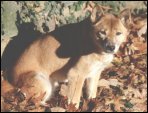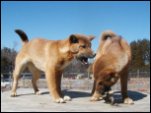|
Contents:
A fancier of Japanese dog breeds looking at pictures of the Australian dingo is involuntarily reminded of the Shiba Inu. Even if there might be differences – the typical fox-like facial expression is simply an invitation to compare the Shiba with the dingo. And also the coat colouring is similar to that of the Shiba, both having multiple red hues as well as black and tan. At first go, who can recognise that the heads on the following pictures belong to dingoes and not to Shibas?
One wonders if this similarity is accidental, a freak of nature, or indeed if there is not any greater common ground. Is it possible that two breeds living so far apart are genetically related? We want to go into this matter.
 Origin and history of the Australian dingo
Origin and history of the Australian dingo
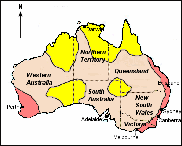 It is widely known that the dingo (Canis lupus dingo) ranks among the feral or pariah dogs and can be found all over the Australian continent (except in Tasmania). He descended from already domesticated dogs which, for unknown reasons, imbruted again. Until recently the dingoes lived isolated from other dog populations in Australia. This has changed greatly in the meantime. On the left figure yellow areas mark regions with pure dingoes, red areas regions in which 90% of the dingoes are hybrids and other areas are regions with many hybrid dingoes. The Australian National Kennel Council (ANKC) controls the breed, other organisations protect the dingoes.
It is widely known that the dingo (Canis lupus dingo) ranks among the feral or pariah dogs and can be found all over the Australian continent (except in Tasmania). He descended from already domesticated dogs which, for unknown reasons, imbruted again. Until recently the dingoes lived isolated from other dog populations in Australia. This has changed greatly in the meantime. On the left figure yellow areas mark regions with pure dingoes, red areas regions in which 90% of the dingoes are hybrids and other areas are regions with many hybrid dingoes. The Australian National Kennel Council (ANKC) controls the breed, other organisations protect the dingoes.
 Reliable insights with more in-depth analysis of the dingo are only now available thanks to a new study based on mtDNA gene analyses. This study was done by a group of scientists lead by the well-known molecular biologist and dog researcher Peter Savolainen (picture) from the Royal Institute of Technology (KTH) in Stockholm. Analysed in this study were 211 Australian dingoes, 676 dogs representing all dog breeds worldwide, 38 Eurasian wolves and 19 archaeological finds of Polynesian dogs.
[1]
Reliable insights with more in-depth analysis of the dingo are only now available thanks to a new study based on mtDNA gene analyses. This study was done by a group of scientists lead by the well-known molecular biologist and dog researcher Peter Savolainen (picture) from the Royal Institute of Technology (KTH) in Stockholm. Analysed in this study were 211 Australian dingoes, 676 dogs representing all dog breeds worldwide, 38 Eurasian wolves and 19 archaeological finds of Polynesian dogs.
[1]
According to the results of this study the dingoes are descended from East-Asian domestic dogs. Their origin was in South China and Taiwan (Formosa) in the so-called Austronesian culture.
[2]
This term is used to describe the culture of agricultural people who lived in this region long before the Chinese, presumably since the Stone Age. Austronesian aborigines still live on Taiwan today.
Characteristics of the Austronesian culture were pottery, the cultivation of rice, millet and sugarcane as well as animal husbandry (pigs, chicken) and the keeping of dogs. Furthermore, the Austronesian people were exceedingly skilful seafarers and fishermen. They covered huge distances on canoes and rafts. About 6,000 years ago the Austronesian people expanded from their original area via the Philippines up to Indonesia. There the movement split in Western and Eastern directions. Towards the west the Austronesians spread out via Thailand/Malaysia as far as Madagascar. Towards the east they expanded via Australia/New Zealand into the whole Pacific, up to the Easter Islands and to Hawaii. Scientists have reconstructed this immense expansion on the basis of Austronesian dialects which are currently spoken by 300 million people (see map).
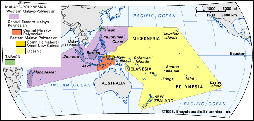
In the course of this expansion the dingo came to Australia along with Austronesian seafarers approx. 5,000 years ago. Savolainen and colleagues assume that this might have happened on a single occasion with a very small population. It is feasible that just one pregnant bitch came to Australia. In any case the contemporary dingo is, due to its isolation from other dog breeds, an extreme product of inbreeding. However, thanks to natural selection the dingo has never shown signs of degeneration.
The study by Savolainen and his colleagues lead to a revision of the commonly-held opinion based on morphological analogies. Until then it was believed that dingoes descended from pariah dogs and Indian wolves. DNA analyses have shown that this assumption is no longer sustainable; in fact Southeast Asia definitely is the dingo's place of origin.
 Common ground?
Common ground?
In Savolainen's study on the origin of the dingo the gene sequences of 96 Japanese dogs were analysed also for comparison. Unfortunately no specific results on this subject have been published thus forcing us to find references to a possible connection between dingo and Shiba elsewhere. Due to the dingo's isolation from other than Australian dogs no immediate points of contact between dingo and Shiba could have occurred. If there is any connection it must be found in a common origin previous to the regional appearance of these two breeds in Australia and Japan. Is such a common origin of dingo and Shiba possible? We would like to bring forward two arguments that make a common origin conceivable, a weaker linguistic-cultural argument and a stronger gene analytic one.
The contemporary Japanese dogs have derived from dogs which came to Japan along with immigrants from two temporarily and regionally different directions. On the one hand these were dogs that advanced approx. 8,000 years ago along with the Jomon people from southern China and Taiwan via the chain of the Ryukyu Islands up to the Japanese main islands. The second group were dogs that derived from north-east Asia and which immigrated via Korea much later together with Yayoi people. The Jomon dogs as well as the Yayoi dogs formed the cadre out of which, by blending breeds, the current Japanese dog populations developed.
[3]
Our linguistic-cultural argument for a possible common origin of dingo and Japanese dogs (and therefore also of the Shiba) is based on the assumption of some scientists that the language of the Jomon people was an Austronesian dialect which was spoken also in Japan until the appearance of the Yayoi people.
[4]
If this is correct and the Jomon people had been indeed of Austronesian ethnic origin then a common origin of the dingo, who descended with great probability from Austronesian speaking people from southern China and Taiwan, and the Japanese dogs is well imaginable. However this is insofar a relatively weak argument as the Austronesian language was completely displaced by the Yayoi culture and there is no written evidence left of the supposed Austronesian language of the Jomon people.
Our second gene analytic argument is closely connected with the first, the linguistic-cultural argument, but unlike that it is provable. Based on the dingo it is considered almost certain that the Austronesian culture during its expansion from China and Taiwan also exported domestic dogs. So if this expansion had also reached Japan, canine gene flows from China/Taiwan could have occurred which should be verifiable in the Japanese dog breeds. Such Chinese (Austronesian) gene flows towards Japan in fact were detected in several studies.
According to the fundamental study by Yuichi Tanabe on the origins of the Japanese breeds there is a "close relationship" among some original Chinese breeds (Chin, Pug, Chow Chow) and the Mino Shiba and the Shikoku.
[5]
Secondly, we can cite a just published gene-analytic study on the Bali Street Dog which is one of the oldest dog populations of the world. In this study as well a genetic relationship has been detected between the Australian dingo and the Japanese Akita on one hand, and the Chinese Chow Chow on the other hand.
[6]
Finally, in the study by Savolainen and his colleagues it was proved that the Australian dingo is genetically related to dogs from Southeast Asia, Siberia, the Indonesian islands and to Japanese dogs.
[7]
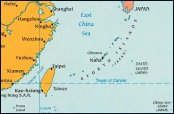 To sum up: the dingo probably came to Australia along with Austronesian seafarers from southern China and Taiwan. The ancestors of the contemporary Japanese dogs, the Jomon dogs, came as well from southern China and Taiwan via the Ryukyu Islands to the Japanese main islands (see map). The Jomon people who brought the first dogs to Japan possibly likewise had their roots in the Austronesian culture. Independent of this question, gene flows by Chinese breeds to Japan have been proved as well as a genetic relationship among dingo and Chow Chow and Akita. If therefore a genetic relationship between the dingo and the Shiba really exists, it only can be founded in a common origin in southern China about 10,000 years ago. The current status of research provides no concrete proof for this common "cradle". The alternative assumption that the similarity between dingo and Shiba is accidental, effected by a so-called "spontaneous mutation", as the genetic term goes, is however even less provable.
To sum up: the dingo probably came to Australia along with Austronesian seafarers from southern China and Taiwan. The ancestors of the contemporary Japanese dogs, the Jomon dogs, came as well from southern China and Taiwan via the Ryukyu Islands to the Japanese main islands (see map). The Jomon people who brought the first dogs to Japan possibly likewise had their roots in the Austronesian culture. Independent of this question, gene flows by Chinese breeds to Japan have been proved as well as a genetic relationship among dingo and Chow Chow and Akita. If therefore a genetic relationship between the dingo and the Shiba really exists, it only can be founded in a common origin in southern China about 10,000 years ago. The current status of research provides no concrete proof for this common "cradle". The alternative assumption that the similarity between dingo and Shiba is accidental, effected by a so-called "spontaneous mutation", as the genetic term goes, is however even less provable.
There might be in some regard similarities between dingo and Shiba, in certain points however they are clearly different. One of these is the difference in size. A grown up dingo reaches about the height of a German Shepherd (up to 23.6 in.) and is thus a great deal bigger than a Shiba. With the next dingo species we want to deal with, is not only its similarity to the Shiba even more amazing but also there is almost no difference in size. We are speaking of the New Guinea dingo.
 The New Guinea dingo
The New Guinea dingo
The New Guinea dingo was detected in the fifties in the high-lying cloud forests of West New Guinea (Irian Jaya) – that is the western half of the island of New Guinea (see picture and map) – by Ellis Troughton who brought a captive pair to the Taronga Zoo in Sydney. In 1958, Troughton gave the newly detected species the scientific name Canis hallstromi after Sir Edward Hallstrom, the President of the Taronga Zoo. From Sydney offspring of the founder pair came to different zoos all over the world, but the scientific interest decreased once this dog temporarily was regarded to be just a savaged domestic dog and not a distinct species.
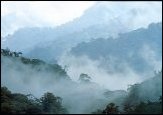
|
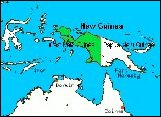
|
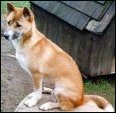 In the seventies a German expedition to New Guinea captured five more examples. Offspring from these dogs also came to the USA where at the beginning of the nineties the Hallstrom dog was scientifically "rediscovered" and analysed using up-to-date methods. Only then was it recognised that the Hallstrom dog together with the Australian dingo forms a distinct sub-species of the domestic dog and both therefore were designated with the scientific name Canis lupus dingo. This collective designation is still controversial, some experts would prefer to name the Hallstrom dog Canis familiaris hallstromi, others Canis lupus hallstromi. With these names some scientists want to express the taxonomic nearness to the domestic dog (Canis familiaris), others to the wolf (Canis lupus). All scholars however agree on the close relationship to the Australian dingo.
In the seventies a German expedition to New Guinea captured five more examples. Offspring from these dogs also came to the USA where at the beginning of the nineties the Hallstrom dog was scientifically "rediscovered" and analysed using up-to-date methods. Only then was it recognised that the Hallstrom dog together with the Australian dingo forms a distinct sub-species of the domestic dog and both therefore were designated with the scientific name Canis lupus dingo. This collective designation is still controversial, some experts would prefer to name the Hallstrom dog Canis familiaris hallstromi, others Canis lupus hallstromi. With these names some scientists want to express the taxonomic nearness to the domestic dog (Canis familiaris), others to the wolf (Canis lupus). All scholars however agree on the close relationship to the Australian dingo.
Outside the scholars' discussion on the correct scientific designation, the New Guinea dingo is better known under the name New Guinea Singing Dog, NGSD for short. This name is due to its singing howls which in this form can neither be found in the Australian dingo nor in any wolf-species. In the internet you can listen to this unique singing per audio file.
[8]
The New Guinea dingo has a set of characteristics that distinguish him completely from other dog breeds, from wolves and even from the Australian dingo.
[9]
These differences are an exciting subject but we want to direct the attention anew to the similarity with the Shiba. We already mentioned the almost identical size (16.5 in.). Pretty similar are also the coat colours, the New Guinea dingo has red, sable and black and tan. Especially interesting is the form of the tail which has no similarity with the Shiba's tail (loose-hanging versus rolled up). The New Guinea dingo also has a loose-hanging tail as the Australian dingo but in some situations (e.g. in presence of possible prey or when displaying confidence) it is rolled up in the same way as with the Shiba. The left picture shows such a New Guinea dingo, the right picture a young adult bearing the tail in the "usual" manner.
[10]
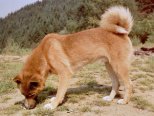
|
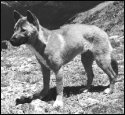
|
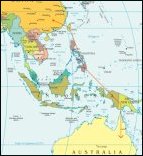 What do we know about a possible background common to New Guinea dingo and Shiba? Researchers agree on a close relationship between the Australian dingo and the New Guinea dingo and assume that both species were brought some thousand years ago by seafarers to their respective new homeland. Under this generally accepted precondition we can with respect to New Guinea dingo and Shiba repeat the arguments that we presented on the subject of Australian dingo and Shiba. If effectively Austronesian seafarers from southern China/Taiwan introduced the Australian dingo to Australia via the Philippines and New Guinea then it is feasible that the New Guinea dingo could also have arrived on New Guinea in this way (probably earlier). On the left map we have drawn the possible route and one can see that the island of New Guinea is, so to speak, on the way. To round off the comparison we "only" have to prove our assumption that dingo and Japanese or Jomon dogs have a common genetic background within the Austronesian culture of southern China.
What do we know about a possible background common to New Guinea dingo and Shiba? Researchers agree on a close relationship between the Australian dingo and the New Guinea dingo and assume that both species were brought some thousand years ago by seafarers to their respective new homeland. Under this generally accepted precondition we can with respect to New Guinea dingo and Shiba repeat the arguments that we presented on the subject of Australian dingo and Shiba. If effectively Austronesian seafarers from southern China/Taiwan introduced the Australian dingo to Australia via the Philippines and New Guinea then it is feasible that the New Guinea dingo could also have arrived on New Guinea in this way (probably earlier). On the left map we have drawn the possible route and one can see that the island of New Guinea is, so to speak, on the way. To round off the comparison we "only" have to prove our assumption that dingo and Japanese or Jomon dogs have a common genetic background within the Austronesian culture of southern China.
However this is enough speculation following on the study by Savolainen and colleagues. Whether related or not – let us hope in the future we will be able to enjoy the sight of dingoes. Even though meanwhile several organisations are admirably committed to the protection and conservation of the New Guinea dingo, he is still greatly endangered.
References
|
[1] |
Savolainen P., Leitner T., Wilton A. N., Matisoo-Smith E., Lundeberg J.: A
detailed picture of the origin of the Australian dingo, obtained from the
study of mitochondrial DNA, Proceedings of the National Academy of
Sciences of the United States of America 101 (2004), pp. 12387-12390.
|
|
[2] |
On Austronesian culture see Peter S. Bellwood: Prehistory of the Indo-Malaysian Archipelago, University of Hawai'i Press 1997.
|
|
[3] |
Yuichi Tanabe: Genetic Evidence for the Routes Dogs Took to Japan, in: Michiko Chiba, Yuichi Tanabe, Takashi Tojo, Tsutomu Muraoka: Japanese Dogs. Akita, Shiba, and Other Breeds, Kodansha International, Tokyo, New York, London 2003, pp. 66-69.
|
|
[4] |
See Mark J. Hudson: Ruins of Identity. Ethnogenesis in the Japanese Islands, University of Hawai'i Press 1999, pp. 82ff and 152ff.
|
|
[5] |
Yuichi Tanabe: The origin of Japanese dogs and their association with Japanese people, Zoological Science, Vol. 8, No. 4 (1991), pp. 639-651 (645).
|
|
[6] |
Irion D. N., Schaffer A. L., Grant S., Wilton A. N., Pedersen N. C.: Genetic variation analysis of the Bali street dog using microsatellites, BMC Genetics 2005, Vol. 6.–
Unfortunately the Akita has been the only Japanese breed chosen for comparison.
|
|
[7] |
See also the summary of Savolainen's study by Leigh Dayton: On the Trail of the First Dingo, Science 203 (2003), pp. 555-556.
|
|
[8] |
Recommendable is the Web site of the New Guinea Conservation Society on which also the standard of the New Guinea dingo is published. Since 1966 the New Guinea dingo has been registered in the USA as a breed in its own right by the
United Kennel Club.
|
|
[9] |
Details in Janice Koler-Matznick, I. Lehr Brisbin Jr., Mark Feinstein and Susan Bulmer: An updated description of the New Guinea singing dog (Canis hallstromi, Troughton 1957), Journal of Zoology 261 (2003), pp. 109-118.
|
|
[10] |
The left picture is taken from Eberhard Trumler: Das Jahr des Hundes. Ein Jahr im Leben einer Hundefamilie, München 1986, p. 13. Unfortunately Trumler does not provide any details on the New Guinea dingo on this picture from the seventies. Presumably this dog comes from a zoo in Germany, possibly Nuremberg. The wolf researcher Trumler dealt intensively with dingoes and according to his own information kept two crossbreeds of Australian and New Guinea dingo.–
The picture on the right shows a New Guinea dingo from a captive population in the USA, it is taken from the article cited in Refer. 9.
|
© 2005 Dr. Holger Funk

|
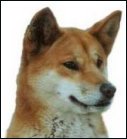

 Origin and history of the Australian dingo
Origin and history of the Australian dingo
 It is widely known that the dingo (Canis lupus dingo) ranks among the feral or pariah dogs and can be found all over the Australian continent (except in Tasmania). He descended from already domesticated dogs which, for unknown reasons, imbruted again. Until recently the dingoes lived isolated from other dog populations in Australia. This has changed greatly in the meantime. On the left figure yellow areas mark regions with pure dingoes, red areas regions in which 90% of the dingoes are hybrids and other areas are regions with many hybrid dingoes. The Australian National Kennel Council (ANKC) controls the breed, other organisations protect the dingoes.
It is widely known that the dingo (Canis lupus dingo) ranks among the feral or pariah dogs and can be found all over the Australian continent (except in Tasmania). He descended from already domesticated dogs which, for unknown reasons, imbruted again. Until recently the dingoes lived isolated from other dog populations in Australia. This has changed greatly in the meantime. On the left figure yellow areas mark regions with pure dingoes, red areas regions in which 90% of the dingoes are hybrids and other areas are regions with many hybrid dingoes. The Australian National Kennel Council (ANKC) controls the breed, other organisations protect the dingoes.
 Reliable insights with more in-depth analysis of the dingo are only now available thanks to a new study based on mtDNA gene analyses. This study was done by a group of scientists lead by the well-known molecular biologist and dog researcher Peter Savolainen (picture) from the Royal Institute of Technology (KTH) in Stockholm. Analysed in this study were 211 Australian dingoes, 676 dogs representing all dog breeds worldwide, 38 Eurasian wolves and 19 archaeological finds of Polynesian dogs.
[1]
Reliable insights with more in-depth analysis of the dingo are only now available thanks to a new study based on mtDNA gene analyses. This study was done by a group of scientists lead by the well-known molecular biologist and dog researcher Peter Savolainen (picture) from the Royal Institute of Technology (KTH) in Stockholm. Analysed in this study were 211 Australian dingoes, 676 dogs representing all dog breeds worldwide, 38 Eurasian wolves and 19 archaeological finds of Polynesian dogs.
[1]
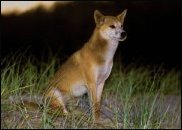
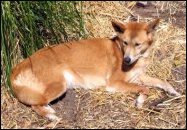
 To sum up: the dingo probably came to Australia along with Austronesian seafarers from southern China and Taiwan. The ancestors of the contemporary Japanese dogs, the Jomon dogs, came as well from southern China and Taiwan via the Ryukyu Islands to the Japanese main islands (see map). The Jomon people who brought the first dogs to Japan possibly likewise had their roots in the Austronesian culture. Independent of this question, gene flows by Chinese breeds to Japan have been proved as well as a genetic relationship among dingo and Chow Chow and Akita. If therefore a genetic relationship between the dingo and the Shiba really exists, it only can be founded in a common origin in southern China about 10,000 years ago. The current status of research provides no concrete proof for this common "cradle". The alternative assumption that the similarity between dingo and Shiba is accidental, effected by a so-called "spontaneous mutation", as the genetic term goes, is however even less provable.
To sum up: the dingo probably came to Australia along with Austronesian seafarers from southern China and Taiwan. The ancestors of the contemporary Japanese dogs, the Jomon dogs, came as well from southern China and Taiwan via the Ryukyu Islands to the Japanese main islands (see map). The Jomon people who brought the first dogs to Japan possibly likewise had their roots in the Austronesian culture. Independent of this question, gene flows by Chinese breeds to Japan have been proved as well as a genetic relationship among dingo and Chow Chow and Akita. If therefore a genetic relationship between the dingo and the Shiba really exists, it only can be founded in a common origin in southern China about 10,000 years ago. The current status of research provides no concrete proof for this common "cradle". The alternative assumption that the similarity between dingo and Shiba is accidental, effected by a so-called "spontaneous mutation", as the genetic term goes, is however even less provable.


 In the seventies a German expedition to New Guinea captured five more examples. Offspring from these dogs also came to the USA where at the beginning of the nineties the Hallstrom dog was scientifically "rediscovered" and analysed using up-to-date methods. Only then was it recognised that the Hallstrom dog together with the Australian dingo forms a distinct sub-species of the domestic dog and both therefore were designated with the scientific name Canis lupus dingo. This collective designation is still controversial, some experts would prefer to name the Hallstrom dog Canis familiaris hallstromi, others Canis lupus hallstromi. With these names some scientists want to express the taxonomic nearness to the domestic dog (Canis familiaris), others to the wolf (Canis lupus). All scholars however agree on the close relationship to the Australian dingo.
In the seventies a German expedition to New Guinea captured five more examples. Offspring from these dogs also came to the USA where at the beginning of the nineties the Hallstrom dog was scientifically "rediscovered" and analysed using up-to-date methods. Only then was it recognised that the Hallstrom dog together with the Australian dingo forms a distinct sub-species of the domestic dog and both therefore were designated with the scientific name Canis lupus dingo. This collective designation is still controversial, some experts would prefer to name the Hallstrom dog Canis familiaris hallstromi, others Canis lupus hallstromi. With these names some scientists want to express the taxonomic nearness to the domestic dog (Canis familiaris), others to the wolf (Canis lupus). All scholars however agree on the close relationship to the Australian dingo.


 What do we know about a possible background common to New Guinea dingo and Shiba? Researchers agree on a close relationship between the Australian dingo and the New Guinea dingo and assume that both species were brought some thousand years ago by seafarers to their respective new homeland. Under this generally accepted precondition we can with respect to New Guinea dingo and Shiba repeat the arguments that we presented on the subject of Australian dingo and Shiba. If effectively Austronesian seafarers from southern China/Taiwan introduced the Australian dingo to Australia via the Philippines and New Guinea then it is feasible that the New Guinea dingo could also have arrived on New Guinea in this way (probably earlier). On the left map we have drawn the possible route and one can see that the island of New Guinea is, so to speak, on the way. To round off the comparison we "only" have to prove our assumption that dingo and Japanese or Jomon dogs have a common genetic background within the Austronesian culture of southern China.
What do we know about a possible background common to New Guinea dingo and Shiba? Researchers agree on a close relationship between the Australian dingo and the New Guinea dingo and assume that both species were brought some thousand years ago by seafarers to their respective new homeland. Under this generally accepted precondition we can with respect to New Guinea dingo and Shiba repeat the arguments that we presented on the subject of Australian dingo and Shiba. If effectively Austronesian seafarers from southern China/Taiwan introduced the Australian dingo to Australia via the Philippines and New Guinea then it is feasible that the New Guinea dingo could also have arrived on New Guinea in this way (probably earlier). On the left map we have drawn the possible route and one can see that the island of New Guinea is, so to speak, on the way. To round off the comparison we "only" have to prove our assumption that dingo and Japanese or Jomon dogs have a common genetic background within the Austronesian culture of southern China.
